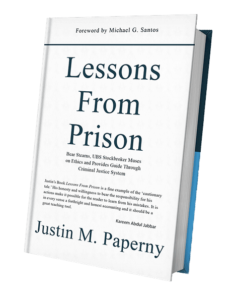If Sean Combs is convicted, the trial won’t be the end of the story. It will be the beginning of another one.
Besides preparing for sentencing, people are already asking a very basic question:
Where will Sean Combs serve his lengthy federal prison sentence?
Immediately after he is sentenced, Combs’ attorney should ask the judge to recommend a specific prison. That recommendation is not binding, but having it on the record can influence the Bureau of Prisons’ designation, especially when supported by a well-documented Presentence Investigation Report (PSR).
Quick refresher on how Sean Combs got here.
Sean Combs was indicted for crimes that span more than a decade. The indictment alleges that between 2008 and his arrest, Combs abused, threatened, and coerced women and others, and led a racketeering conspiracy that engaged in sex trafficking, forced labor, kidnapping, arson, bribery, and obstruction of justice.
U.S. Attorney Damian Williams stated:
“As alleged in the Indictment, for years, Sean Combs used the business empire he controlled to sexually abuse and exploit women, as well as to commit other acts of violence and obstruction of justice. Today, he is charged with racketeering and sex trafficking offenses. If you have been a victim of Combs’ alleged abuse – or if you know anything about his alleged crimes – we urge you to come forward. This investigation is far from over.”
If he is convicted, the next phase will happen fast. He’ll begin preparing for his Presentence Investigation Report (PSR), sentencing, then wait for the Bureau of Prisons to determine where he’ll serve his time.
The First Step Act that Prison Professors Charity helped pass aims to place people within 500 miles of their home. Since Combs has residency in both Florida and California, he may request FCI Coleman Medium in Florida or FCI Victorville Medium in California. If he qualifies for a low-security designation, he might ask for Terminal Island or Lompoc. But based on the seriousness of the charges, the sentencing guidelines, and public safety flags, the more likely outcome is a medium-security designation—at least initially.
Combs was taken into custody and denied bail. The court ruled he posed a danger to the community and a flight risk. He’s currently housed at MDC Brooklyn, but that’s temporary. If convicted, his final destination will mostly depend on his PSR and the Bureau of Prisons designation.
What You Need to Know About Federal Prison Designation (And Why It Starts Before Sentencing)
If you’re facing a sentencing hearing in federal court, one of the most overlooked—but essential—steps is understanding how the Bureau of Prisons will determine your federal prison designation.
The designation process isn’t random. And it’s not something to leave to chance, though too many do. With the right preparation, you can influence it. But if you show up at sentencing with no plan, no supporting documents, and no advocacy—don’t be surprised if your federal prison designation doesn’t meet your medical, educational, or program needs.
The Bureau of Prisons currently confines over 140,000 people. About 30,000 of those are in minimum-security federal prison camps. The rest are spread across low, medium, high-security prisons, and administrative facilities. My partner Michael Santos served time in almost every type of federal facility during his 26-year term. He learned how the BOP assigns custody levels and how those decisions affect access to programs, proximity to family, and the likelihood of early release. I’ve learned from him and from the people our team has guided over the years.
Where the Federal Prison Designation Begins: The DSCC
The Designation and Sentence Computation Center (DSCC), located in Grand Prairie, Texas, is where the Bureau of Prisons decides where you’ll serve your sentence. They review:
- Your judgment and commitment order
- Your Presentence Investigation Report (PSR)
- The Statement of Reasons from the judge
- Any detainers or pending state matters
- A summary report from the U.S. Marshals
You won’t speak to anyone at the DSCC. This process happens behind closed doors, based only on paperwork—most of which you can influence before sentencing.
In Combs’ case, his PSR will reflect the gravity of the charges and the outcome of his trial. If the report includes a serious public safety factor (PSF)—which is likely, given the nature of his alleged conduct—he will not be eligible for a camp. If his sentence is over 20 years, he may also be ineligible for a low-security facility at the outset, regardless of other factors.
How the BOP Scores You (And What That Means for Sean Combs)
The Bureau of Prisons assigns you a security score based on:
- Severity of your current offense
- History of violence or escape
- Criminal history
- Whether you voluntarily surrendered
- Educational background
- Detainers or pending charges
- Drug or alcohol abuse
Voluntary surrender is one of the only ways to lower your score. If you qualify, do it. I had the good fortune of being able to self-surrender to a minimum-security camp on April 28, 2008, to begin serving my 18-month sentence.
Sean Combs does not qualify for voluntary surrender. He was taken into custody and held pretrial. That decision, while unrelated to guilt, raises his score, reduces his initial placement options, and reinforces the Public Safety Factor (PSF) tied to the severity of his alleged conduct.
Here’s how that score will likely break down:
- Severity of Offense: The allegations—sexual exploitation, narcotics—rank among the most serious in the BOP classification system. This will push him toward medium or high-security custody.
- Criminal History: Combs has no prior federal convictions, which helps. But that won’t outweigh the seriousness of the current case.
- Voluntary Surrender: Denied bail and in custody, Combs is ineligible.
- Public Safety Factors (PSFs): Likely to apply, disqualifying him from minimum-security placement even if his score suggests otherwise.
Medical Needs Are Also a Factor
The BOP uses a four-level Care system:
- Care Level 1 – Healthy, under age 70
- FPC Pensacola, FPC Montgomery, FCI Miami (Low), FCI Jesup (Low)
- FPC Pensacola, FPC Montgomery, FCI Miami (Low), FCI Jesup (Low)
- Care Level 2 – Chronic but stable (e.g., diabetes)
- FCI Coleman Low, FCI Elkton, FCI Fort Dix, FCI Aliceville (women)
- FCI Coleman Low, FCI Elkton, FCI Fort Dix, FCI Aliceville (women)
- Care Level 3 – Requires frequent care for serious illness
- FCI Butner Medium I & II, FMC Devens, FMC Rochester, FMC Carswell
- FCI Butner Medium I & II, FMC Devens, FMC Rochester, FMC Carswell
- Care Level 4 – 24/7 skilled nursing or inpatient care
- FMC Carswell, FMC Lexington, FMC Devens, FMC Fort Worth
- FMC Carswell, FMC Lexington, FMC Devens, FMC Fort Worth
If Combs has documented medical or mental health needs, those may affect his placement. Ghislaine Maxwell was designated to FMC Carswell. R. Kelly is serving his sentence at Butner Medium II for similar reasons.
Distance from Home and the First Step Act
Since the First Step Act passed in 2018, the BOP is supposed to designate people within 500 driving miles of their primary residence—if program and security needs allow it.
In practice, I’ve seen people placed close to home and others sent across the country. The difference usually comes down to preparation—or lack of it.
Combs may request Coleman in Florida or Victorville in California. If designated to a low-security prison, he would likely ask for Lompoc or Terminal Island, both of which house people with similar backgrounds and sentence lengths.
What You Need to Know About Victorville, Lompoc, and Terminal Island
Victorville Medium, located in California, opened in 2004 as part of the Victorville Federal Correctional Complex. It is distinct from the adjacent USP Victorville. There is also a nearby camp for women.
Our team has worked with more than a hundred women who served time at Victorville. Many of them described the consequences of serving near an active penitentiary. If there’s a riot or lockdown at the USP, all adjacent facilities—including the women’s camp—can be locked down as well.
Victorville Medium offers basic medical and dental care, medications (which should be listed in the PSR), sick call, and emergency services. The facility also runs the Residential Drug Abuse Program (RDAP). Combs would only be eligible for RDAP if he discloses a substance use history during his PSR interview and that disclosure is accepted and documented.
If convicted, Combs will sit for his probation interview within 30 days. His attorneys will review the PSR before sentencing. They may object to certain portions, but the probation officer is not required to accept those objections. The judge may rule on them at sentencing.
FCI Lompoc
Federal Correctional Institution Lompoc (Low) is located on California’s Central Coast, about an hour north of Santa Barbara. It opened in 1975 and is part of the larger Lompoc Federal Correctional Complex, which also includes a U.S. Penitentiary and a minimum-security satellite camp.
Lompoc uses dormitory housing. Movement is structured, and the perimeter is secured with barbed wire. Despite being a low-security prison, it houses individuals convicted of serious offenses, including sex offenses, white-collar crimes, and drug conspiracies. Most are within 20 years of release, which often results in fewer incidents of violence compared to medium or high-security institutions.
Lompoc offers GED and ESL education, vocational trades like welding and HVAC repair, and a UNICOR factory where individuals manufacture furniture and textiles. It is classified as Care Level 2. Medical services are available onsite, but offsite transport is often required for specialized care. Travel for visiting can be difficult for families without access to flexible transportation.
FCI Terminal Island
Federal Correctional Institution Terminal Island is located between San Pedro and Long Beach. Built in 1938, it has undergone renovations but retains many features of its original design. Its location—completely surrounded by water—limits physical space and movement.
Terminal Island is used for a range of federal convictions, including sex offenses, white-collar cases, and drug crimes. Its location makes it one of the most requested facilities for people with Southern California ties and medical concerns.
Terminal Island is also classified as Care Level 2. It offers dental care, chronic care clinics, and access to nearby hospitals in Los Angeles. Educational and job training programs include GED classes, computer literacy, warehouse operations, and custodial training. While small, it has fitness and TV areas, and a standard $360/month commissary allowance. As with other BOP prisons, visitation is offered but frequently suspended due to staffing or operational issues.
Both Lompoc and Terminal Island offer RDAP, aka, The Residential Drug Abuse program
Medium vs. Low Security: What Combs Could Expect
Medium-security prisons house people with longer sentences, myriad prior convictions, or violent backgrounds. These prisons often resemble the jail environments you see on TV or in the movies: cell-based housing, toilets inside cells, controlled movement, and higher potential for violence. In medium-security prisons, people often align themselves with groups or cars for protection. The staff-to-prisoner ratio is higher because of the risk level.
Low-security prisons are still fenced and secured, but they use dormitory housing. They tend to house people within 20 years of release. When someone knows they’ll be released in 5, 10, or even 15 years—not 30 or 40—the behavior tends to shift. While violence isn’t absent, it’s less common. Group dynamics still exist, and some people do “check in” with certain groupls for protection. But the intensity and volatility are generally lower.
Visitation in most prisons is typically allowed on weekends. Families should check the facilitator location at www.BOP.gov to ensure visiting is not currently suspended.
Designation is not random. It’s based on what the PSR says, what’s documented or left out, and how the BOP interprets risk, history, and program eligibility.
What Actually Influences Designation
Designation decisions are made by staff at the DSCC based on documents—nothing more. If a person assumes they’ll be sent to a camp or low, but hasn’t corrected their PSR, submitted a release plan, or addressed detainers or health history, the odds of a favorable designation drop. I’ve seen people end up at a medium or low because of one unchecked detail.
I’ve also seen people with more complicated records earn more favorable placements because they took the process seriously. They prepared early, corrected errors, and built a full record before sentencing.
What You Can Do
If you’ve already been sentenced, your options are limited. But if you’re in the pre-sentencing phase, this is when you can still influence everything:
- Fix errors in your PSR
- Ensure the Statement of Reasons is accurate
- Request voluntary surrender (if eligible)
- Submit a clear release plan
- Provide documentation about medical issues or program eligibility
- Gather letters of support from credible sources
Sean Combs’ legal team will likely ask for a prison recommendation. But the BOP doesn’t follow those unless the record supports the request. If you want to serve your sentence where your needs are met—and your risks are reduced—you must prove that placement makes sense.
If You Need Help
Every Tuesday, our team hosts a webinar covering the PSR, sentencing prep, designation, and early release strategy. We take questions and walk through real cases—including how people earned RDAP, avoided halfway house delays, or corrected their designation mid-sentence.
You can join anonymously. You can listen quietly. But don’t go through this without a plan.
See you Tuesday,
Justin Paperny



